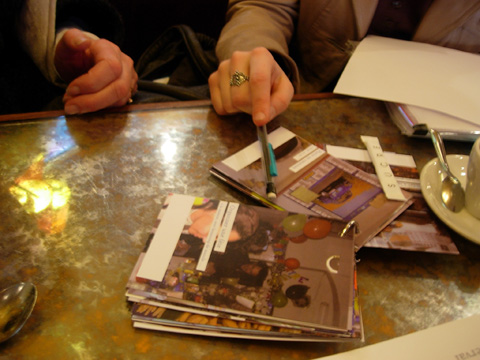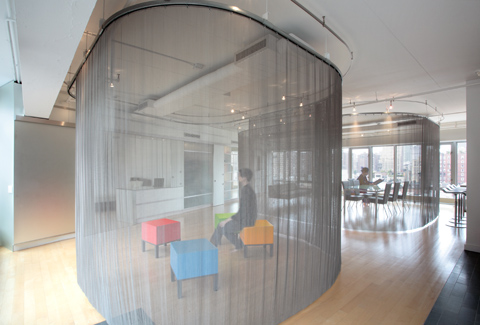A new book, Architecture & Design versus Consumerism: How Design Activism Confronts Growth (Earthscan/Routledge 2012), helps designers and design enthusiasts use activism generally and confront consumerism more particularly. This excerpt launches a virtual book tour during October and November and it profiles design’s role altering our societal narratives about ownership and sharing.
With the rise of collaborative consumption, the societal narrative about ownership and use is beginning to change. Whereas a consumerist mantra has been, “Why rent when you can own?” or even “Mine, right now!” according to Simon Smith (on Shareable) the collaborative consumption mantra is “Ownership is a last resort.” Commenting on how the purpose of consumerism is ownership, he highlights the point that “No successful marketing campaign will promote the risks, side effects, and negative repercussions of ownership,” even though ownership has some notorious downsides.
Designers, though, have begun exploring the idea of shared consumption. One example is MIT Media Lab’s Smart Cities Group. This group developed the concept of a city car, a publicly shared car system that works in conjunction with mass transit for the “last mile” of local trips. The cars are small and stack-able (like grocery carts — six to eight of them can fit into one parking space) and have an innovative design. The traditional engine and drive train are replaced by robotic wheels which each contain their own motor and steering and braking. When parked, the cars harvest and store solar energy.
This example shows that the conscious design of objects for the purpose of shared use can make them considerably smarter and more efficient than conventional models. Architects Jinhee Park and John Hong of SsD explored the design of a New York City apartment for the purpose of sharing among several families who are in the city at different times. A curtain wall system, among other features, allows users to customize the space in temporary ways.

Customizing space in temporary ways with curtain walls at HBNY by SsD. Photo courtesy of SsD.
In another approach, designers are involved in designing the process for sharing. An example comes from a design school in Paris (Ecole national superieure des Arts Décoratives) where three students — L. Bayon , M. Jaloux, and V. Willerval — in conjunction with tutors François Jégou and Anna Bernagozzi, collaborated with the Logement Intergénérations (Intergenerational Lodging) association.
The idea was to create a way for students, who could rarely afford inner-city residences, to find rooms with elderly inner-city residents living alone. The process of creating these new “couples” — student with senior — requires that the intentions on both sides of the prospective pair are compatible, especially in terms of mutual aid. The design team created enabling cards that pictorially prompt prospective couples’ discussions on a wide range of issues, including tidiness, smoking, overnight guests, birthdays and holidays, and so on.

Enabling cards help people to build a narrative about what their shared home might be like. Photo courtesy of François Jégou.
Kate Fletcher’s Local Wisdom project takes a different tack by identifying where people are already sharing and extrapolating design implications from that. By exploring why people keep and share clothes over long periods, one finding concerned how users encounter overlock stitching as a barrier to modifying, adapting, and reusing clothing and textiles, which then needlessly shortens the life of many garments. The Local Wisdom project highlights and celebrates these stories of self-organized sharing through exhibits that include photographs and histories.

One dress, three generations — Kate Fletcher’s Local Wisdom project tracks how people share garments and articulates the “craft of the user.” Photos courtesy of the Local Wisdom project, shot by Sean Michael.
In these examples of collaborative or shared consumption, the emphasis shifts from the immediate rewards based on purchase and ownership — my car, my dress, my house — to a model where reward potentially comes from what Kate Fletcher calls “the craft of users” in her book chapter “Post Growth Fashion and the Craft of the Users.” Reward and stimulation in this model are paced by new patterns of access, such as planning ahead to reserve a car or negotiating with sharing partners. The quality of stimulation is also different, shifting from the acquisition and care of things, to the development of relationships within the system of use.
***
To learn about other key challenges of consumerism and how designers are responding pick up a copy of Architecture & Design versus Consumerism (Earthscan/Routledge 2012) from Amazon.com or use the 20% discount code BRK96 at Routledge. Follow the tour on twitter #DvC12 and at these tour stops during October and November: Oct 2 and 4 — Shareable; Oct 9 —Polis; Oct 16 and 18 — Green Conduct; Oct 23 — Transforming Cultures (Worldwatch); Oct 30 — Post Growth Institute; Nov 6 — no tour stop so get out and VOTE; Nov 13 — The Dirt (American Association of Landscape Architects); Nov 20 —Proto City.
About the Author
Ann Thorpe (Ann at designactivism dot net) is a Seattle- and London-based collaborative design strategist known for her generously illustrated talks that audiences describe as “brain-opening,” “intriguing and insightful,” and full of “unusual angles.” She currently serves as strategist with a Seattle-based startup, a social enterprise called luum. She is also the author of The Designer’s Atlas of Sustainability.









